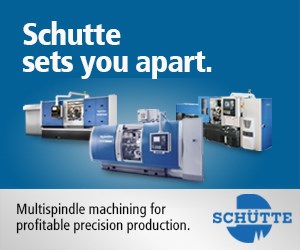
A variety of machining elements should be considered when measuring sustainability within a machine shop environment.Source: Haimer
Sustainability is a topic that is rightly becoming increasingly important given that resources are limited and energy is expensive.
There are many facets of this when it comes to machining. Depending on the part material, geometry and quantities, a variety of machine tools, tooling and clamping devices can be used. External circumstances such as production location, employee qualifications and possible automation must also be considered. There are many different manufacturing options that can be the best, most economical and most sustainable solution depending on the individual case, but it is difficult not to compare apples with oranges here.
So, how is sustainability in a machine shop measured? Apart from the materials used, energy efficiency is probably the main factor that determines the level of process sustainability. Therefore, a helpful approach is to look for the largest energy consumers and optimize their use.
The machine tool offers significant savings potential as it consumes the majority of the energy used with its spindle and axis drives, peripherals and auxiliary units such as cooling, lubrication and compressed air supply. When purchasing new machines, the user can significantly reduce consumption by paying attention to energy-saving components.
In Haimer’s production environment, the company has learned that replacing an old machining center with a new one that performs the same machining process typically consumes approximately 30% less energy. However, not every old machining center can be replaced with a new one. Savings can also be made in the machining process by way of CAD/CAM-optimized toolpath strategies such as trochoidal milling.
For instance, a customer provided Haimer with data showing how it was able to reduce machining time from 71 minutes to 18 minutes per part (a 75% reduction) by using trochoidal milling with the Haimer Power shrink-fit chucks and Haimer Mill cutters compared to its original face-milling process. The change in machining strategy was accompanied by energy savings due to significantly lower power consumption. The spindle load for the original face-milling process was 80 to 85% for 10 parts, resulting in a total energy cost of approximately $150. The spindle load using the trochoidal milling strategy was only 8 to 10% with significantly shorter cycle times yielding total energy cost of $5 for 10 parts.
The energy consumption of a shrink-fit toolholding system (a collet application shown here) is minimal compared to other elements of a machining process. Source: PM
A Holistic Approach to Toolholding
Still, have you ever thought about how a toolholder might contribute to sustainability? In view of a machining process in which the milling machine consumes an average of 30 kW, plus the power of hydraulic and pneumatic workholding devices, automation equipment and robots, toolholding only plays a subordinate role. This is because the toolholder is a comparatively small detail, even if the clamping process with a shrink-fit chuck consumes a marginal amount of energy.
Looking at other clamping systems, the energy consumption during shrink fit is higher in operational use than with a hydraulic or milling chuck. That said, if you look at the entire product life cycle of a toolholder, which includes production, maintenance and disposal, a different picture emerges.
The production of a hydraulic chuck requires significantly more effort and energy due to its more complicated structure. In addition to the precision machining of individual components, there is also the soldering of the expansion sleeve, additional heat treatment to prevent the solder joint from breaking, as well as the effort required for cleaning, assembly and filling with oil.
In addition to shrink-fit chucks, Haimer also offers hydraulic chucks, although their list prices are two to three times higher than shrink-fit chucks due to the complex production process. And from the company’s experience, the energy required for hydraulic chuck production is approximately three times as high as a shrink-fit chuck.
Although hydraulic chucks can be the right solution for certain applications, they are not more sustainable than shrink fit. Our analysis has shown that a hydraulic chuck requires approximately 25 kWh more energy to manufacture than a shrink-fit chuck. In terms of the product life cycle, a shrink-fit chuck with an energy requirement of 0.026 kWh per shrink fit and cooling cycle can be shrunk almost 1,000 times before it consumes more energy than hydraulic chuck production. The same applies to milling chucks, which are much more complicated and contain more components as well as grease and lubricants.
Life Cycle and Process Reliability
In addition to the increased manufacturing costs, there is also the difference in terms of maintenance. Haimer shrink-fit chucks are essentially maintenance-free due to the quality of the hot-work tool steel, and tools can be shrunk in and out using the company’s coil/shrink-fit technology virtually an unlimited number of times. Hydraulic chucks and milling chucks have to be returned to the manufacturer every two to three years at minimum to check the clamping force, lubricate the clamping screw or grease the system and carry out regular maintenance of the chuck due to wear. The contained hydraulic fluid or grease also makes environmentally friendly disposal more difficult than with shrink-fit chucks, which do not contain any additional components.
In addition to the life cycle, there are also significant differences in terms of process reliability. In the event of dry machining or insufficient cooling in the machining process, hydraulic chucks pose the risk of their clamping chambers bursting due to the high heat development, which could lead to tool pull-out and the risk of scrap. Shrink-fit chucks are more robust and durable in this respect. In addition, the Haimer Safe-Lock system is available for shrink-fit chucks to help prevent tool pull-out.
Energy Consumption During Shrink-Fit
But how is energy consumption calculated during the shrinking process? Heating a shrink-fit chuck takes approximately five seconds using a modern Haimer shrink-fit machine. Experienced users can shrink a worn cutting tool and shrink a new cutting tool in a single operation. The toolholder is therefore only heated and cooled once.
Andreas Haimer, president of Haimer Group, says his family business pays a lot of attention to sustainability. For example, it sources its steel for tools from Germany, has been using electricity exclusively from renewable energy sources for years and is investing in solar energy systems and green infrastructure. Here, he holds the company’s new Hybrid Chuck, said to combine the vibration-damping properties of a hydraulic chuck with those of a precision shrink-fit chuck. Source: Haimer
The maximum output of a Haimer Power Clamp shrink-fit machine with NG coil is 13 kW, but the average is 8 kW. This means that a single, complete shrinking process consumes approximately 0.011 kWh. In addition, cooling consumes approximately 0.015 kWh, although Haimer devices can cool as many as five holders in parallel and at the same time with almost the same energy consumption. In the worst-case scenario, this results in a total of 0.026 kWh for the entire process. If a kilowatt hour costs 20 cents, shrinking and cooling a tool costs a marginal 0.5 cents.
And how should the energy consumption be classified when considering the machining process in which the power consumption of a milling machine with all auxiliary drives is approximately 30 kW? Assuming that a tool is in use for one hour and that even just 1% of the machining time can be saved thanks to the high concentricity and rigidity or the improved milling strategies due to the slim toolholder contour, that would be 0.3 kWh of energy saved. This is approximately 11 times the amount of energy used for shrinking.
Therefore, the energy consumption per clamping process plays a negligible role compared to the issues of life cycle, process reliability and machining strategy. Plus, modern CAD/CAM-optimized milling strategies can save a high percentage of machining time. Machinists must focus on such improved processes if they want to be both sustainable and productive. And in a second step, they should select the most suitable and process-reliable toolholder to align with these strategies.
Related Content
Monaghan Compensation Chucks Convert Standard ER Holders
Diatool ER Hydraulic Compensation Chucks enable users to convert standard ER holders to a repeatable, steerable hydraulic chuck for more precise machining.
Read MorePSZ Turn Modular Quick-Change System for Swiss Lathes
Sumitomo’s PSZ Turn system provides good ergonomics and efficiency by offering a fast, reliable process and convenient cassette changes.
Read MoreCoolant-Through System, Toolholders for Improved Efficiencies
Eastec 2023: The reCool retrofittable reCool coolant-through system converts existing flood-cooled driven tools on turning machines to through-tool, coolant-capable in as little as two minutes, while the powRgrip high-precision toolholding system is said to generate extremely high clamping forces equal to or higher than shrink-fit holders.
Read MoreIscar Neo Swiss Quick-Change Toolholders for Swiss-Types
IMTS 2022: Neo Swiss modular quickchange tooling line for Swiss-types feature a rotary wedge mechanical design for clamping rigidity and accuracy.
Read MoreRead Next
Replaceable-Insert Spade Drill Basics, Advantages
Although solid carbide and indexable-insert drills have their place in a machine shop, replaceable-insert spade drills offer specific advantages for various holemaking operations on machining centers and lathes.
Read MoreBroaching Tool Technology For Lathes Used to Slot Inconel Parts
This shop finds value in using an indexable-insert-style broaching tool to create blind-hole slots in heat-treated Inconel aerospace parts on a CNC lathe.
Read MoreMicromachining Fundamentals
A number of elements must come together to establish an effective process for machining at a micro level. Here we consider four.
Read More
































